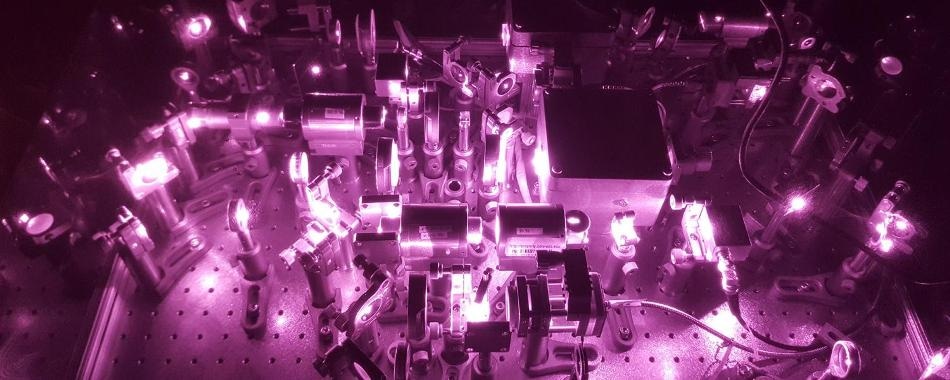Apr 4 2019
The concept of trapping single atoms can be applied to herding cats, which makes scientists at the University of Colorado Boulder skilled feline wranglers.
 A photograph of an infrared “optical tweezers” device. Normally, the light from such lasers would be invisible to the naked eye. (Image credit: Mark Brown)
A photograph of an infrared “optical tweezers” device. Normally, the light from such lasers would be invisible to the naked eye. (Image credit: Mark Brown)
In a recent study, a research team headed by physicist Cindy Regal demonstrated that it can possibly load sets of single atoms into huge grids with an efficiency unparalleled by current techniques.
When it comes to harnessing quantum physics, lone atoms are considered to be a possible building block. If investigators are able to capture and regulate these small pieces of matter with lasers, they can produce innovative kinds of materials that act in unusual ways. In addition, they can potentially lead to quantum computers that may substitute conventional number crunchers in the future.
According to the researchers, that’s a big “if.” Similar to those cats, atoms without a charge, or neutral atoms, cannot be tamed easily: they move quickly around, hit into one another, and never remain still for long. This is where Regal and her coworkers come in.
In a study recently reported in Physical Review X, the researchers reported that with the help of small laser beams, also known as “optical tweezers,” they were successfully able to trap single, neutral rubidium atoms with a probability of 90%.
The latest study is a step forward for conquering the atoms’ slippery dynamics, stated Regal, an associate professor in JILA and the Department of Physics at CU Boulder.
Bits in a quantum computer will necessarily be tiny things. And every tiny thing presents its own challenges for wrangling.
Cindy Regal, Physicist and Associate Professor, Department of Physics, JILA, University of Colorado Boulder
It is a method that can be exploited by many researchers, added Mark Brown, one of the two lead authors of the latest paper.
Everyone in our field has to load atoms. So if you have a better technique for catching atoms, then many people can make use of this.
Mark Brown, Study Lead Author and Graduate Student, Department of Physics, JILA, University of Colorado Boulder
Improving the odds
So far, researchers have turned to several methods in order to load their atoms, including the use of optical tweezers. In that method, the team initially criss-crossed an array of laser beams to trap floating atoms and then cool them down.
Subsequently, it was time to winnow. When the scientists meticulously tweaked the energy of their lasers, they found that they can alter the behavior of their captured atoms, causing them to hit into one another. Those collisions displace atoms from the trap in pairs of two, similar to scrapping alley cats.
Ultimately, one is left with only a single, surviving atom, or at the most, that’s what occurs approximately half of the time, informed Brown.
“If you kick out all of the pairs of atoms, then you’re either left with one atom or zero atoms,” he stated.
Brown’s team wished to do better than a 50% success rate. Hence, the researchers started to use lasers with a somewhat varied color than is typically selected by atom-trappers.
It was observed that the rubidium atoms, under this novel illumination, no longer crashed but rather repelled one another similar to pressing together the same poles of two magnets, stated Tobias Thiele, the study’s other lead author.
You can now make it so that one of the atoms stays in the trap and the other one goes very far away. You end up with only one atom in the trap about nine times out of 10.
Tobias Thiele, Study Lead Author and Postdoctoral Researcher, Department of Physics, JILA, University of Colorado Boulder
Thiele works in Regal’s lab.
Getting organized
With that extent of control, the team can possibly separate many numbers of atoms and also arrange them in a more efficient manner. In the latest work, the researchers described that these atoms could be organized into perfect six-by-six grids, all in a fraction of the time of existing tools.
The team, which also included graduate students Ting-Wei Hsu and Chris Kiehl, are currently working to increase that number, beginning from 36 trapped atoms to hundreds or maybe thousands. That is when the fun starts. After these 2D- or even 3D lattices are maintained, the researchers can selectively tell single atoms to bond with a neighbor via a process known as quantum entanglement. Such entanglement, where a single atom is essentially linked to another, lays the groundwork for quantum computers, stated Thiele.
“The nice thing about this system is that you can turn the interactions on and off only when you want to,” he stated. This indeed makes for some well-behaved cats.